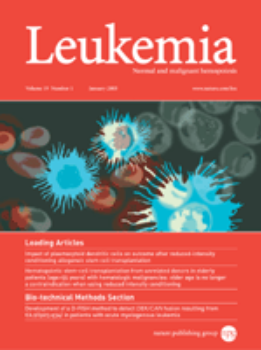Bidirectional anti-tumor and immunological strategies by targeting GARP–TGF-β axis in adult T-cell leukemia/lymphoma
IF 13.4
1区 医学
Q1 HEMATOLOGY
引用次数: 0
Abstract
In adult T-cell leukemia/lymphoma (ATL), tumor cells show a regulatory T-cell (Treg)-type phenotype, which influences their tumor immunity. However, our knowledge of what molecular events are involved in pathogenesis is still missing. Here, we took advantage of this unique phenotype and screened whole transcriptome data from primary ATL cells to search for effective therapeutic targets. Glycoprotein A repetitions predominant (GARP) was identified as a novel tumor antigen in ATL. ATL cells overexpress GARP and release transforming growth factor-β (TGF-β). The GARP–TGF-β axis promotes cell proliferation of ATL cells and human T-cell leukemia virus type 1 (HTLV-1)-infected cells with changes in cell signaling activities and shaping of Treg gene expression patterns, but suppresses the activity of surrounding effector T-cells. Remarkably, this study has provided a breakthrough therapeutic concept that achieves the dual effect of direct tumor cell depletion and indirect immune activation by a single treatment targeting GARP. DS-1055a, an anti-GARP monoclonal antibody, selectively and effectively depleted malignant ATL cells via antibody-dependent cellular cytotoxicity, supporting the proof-of-concept in the preclinical study. Our findings highlight the key to understanding the cell origin of ATL and developing unprecedented therapeutic strategies for refractory diseases.

GARP-TGF-β轴在成人t细胞白血病/淋巴瘤中的双向抗肿瘤和免疫策略
在成人t细胞白血病/淋巴瘤(ATL)中,肿瘤细胞表现出调节性t细胞(Treg)型表型,影响其肿瘤免疫。然而,我们对发病机制中涉及的分子事件的了解仍然缺失。在这里,我们利用这种独特的表型,筛选来自原代ATL细胞的全转录组数据,以寻找有效的治疗靶点。糖蛋白A重复显性抗原(GARP)是ATL中一种新的肿瘤抗原。ATL细胞过表达GARP并释放转化生长因子-β (TGF-β)。GARP-TGF-β轴通过改变细胞信号活性和形成Treg基因表达模式,促进ATL细胞和人t细胞白血病病毒1型(HTLV-1)感染细胞的细胞增殖,但抑制周围效应t细胞的活性。值得注意的是,本研究提供了一种突破性的治疗理念,通过一次靶向GARP的治疗,实现了直接肿瘤细胞消耗和间接免疫激活的双重效果。DS-1055a是一种抗garp单克隆抗体,通过抗体依赖性细胞毒性选择性有效地清除恶性ATL细胞,支持临床前研究的概念验证。我们的发现强调了理解ATL细胞起源和开发难治性疾病前所未有的治疗策略的关键。
本文章由计算机程序翻译,如有差异,请以英文原文为准。
求助全文
约1分钟内获得全文
求助全文
来源期刊

Leukemia
医学-血液学
CiteScore
18.10
自引率
3.50%
发文量
270
审稿时长
3-6 weeks
期刊介绍:
Title: Leukemia
Journal Overview:
Publishes high-quality, peer-reviewed research
Covers all aspects of research and treatment of leukemia and allied diseases
Includes studies of normal hemopoiesis due to comparative relevance
Topics of Interest:
Oncogenes
Growth factors
Stem cells
Leukemia genomics
Cell cycle
Signal transduction
Molecular targets for therapy
And more
Content Types:
Original research articles
Reviews
Letters
Correspondence
Comments elaborating on significant advances and covering topical issues
 求助内容:
求助内容: 应助结果提醒方式:
应助结果提醒方式:


